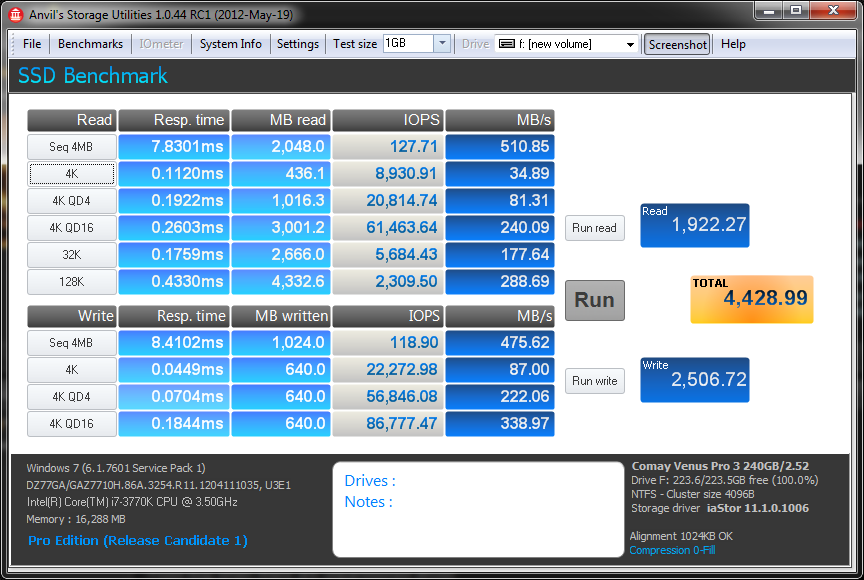ANVIL STORAGE UTILITIES PROFESSIONAL (BETA)
You may not see this for long (and its definitely not common) but you get a freebee simply for reading! Over the last little while, we have been assisting with beta besting new benchmark software called Anvil Storage Utilities which is an absolutely amazing SSD benchmarking utility. Not only does it have a preset SSD benchmark, but also, it has included such things as endurance testing and threaded I/O read, write and mixed tests, all of which are very simple to understand and utilize in our benchmark testing.
ASU – 0FILL (COMPRESSIBLE DATA)
 The newest version of Anvil Storage Utilities is RC1 and, unlike previous versions, its standard test pattern tests incompressible data much like AS SSD. For this reason we have included both the former oFill (or compressible) results above and incompressible below.
The newest version of Anvil Storage Utilities is RC1 and, unlike previous versions, its standard test pattern tests incompressible data much like AS SSD. For this reason we have included both the former oFill (or compressible) results above and incompressible below.
ASU INCOMPRESSIBLE DATA
 With full identification of our Z77 Test Bench on the left and the Comay Venus Pro 3 SSD on the right, ASU easily surpasses any other synthetic benchmark available and compounds that with both transfer speed and IOPS results. We can see in the first chart that the 86,000 IOPS result meets specifications but, something that is excellent to see in such a utility are the extremely low disk access times.
With full identification of our Z77 Test Bench on the left and the Comay Venus Pro 3 SSD on the right, ASU easily surpasses any other synthetic benchmark available and compounds that with both transfer speed and IOPS results. We can see in the first chart that the 86,000 IOPS result meets specifications but, something that is excellent to see in such a utility are the extremely low disk access times.
HDTUNE PRO VER. 4.6
HDTune Pro is a great software program that lets us have a look at all aspects of testing through several separate tests. For today’s testing, we are only going to include Random Testing and Extras in order to demonstrate how well the Comay Venus Pro 3 operates in SATA 3 transfer speeds:
 The SSD Review The Worlds Dedicated SSD Education and Review Resource |
The SSD Review The Worlds Dedicated SSD Education and Review Resource | 
tbh i was hoping this new pro version SSD would do extremely well, was really looking foward to a sandforce drive out perform the plextor m3pro. currently sandforce drives been doing pretty well with the incompressible data at over 300mb/s but thats just crystaldisk though, which shows the best possible results unlike AS SSD which shows the worst possible result.
quite frankly the lowest results showing in AS SSD for plextorm3p are way too good, and its access time simply amazing lol. sandforced write latency usually around .18-.2 ms, just cant beat marvel/samsung controller.
i’ll probably just wait till something* that has really good 4k speed, something a bit better than the intel 520 drives
you can buy this product with contact iPCZEN.
http://www.ipczeninformatique.fr
I’ve always wondered just how much a supercap adds to the price of an SSD. I suspect very little. These should have been standard on all models, not just the enterprise ones. Just a marketing gimmick to boost prices.
As for access time performance you have to be cautious here. A controller designer can use DRAM as a crutch to boost performance and there is always a tradeoff. In this case it’s an incrfeased risk of data corruption or loss. The large DRAM cache becomes a data integrity risk as well as performance enhancer. Hell, if you used enough DRAM you could achieve RAMDISK performance across the board.
The supercap adds a few $s to the BOM, depending on the size of the cache, and whether the device/controller operates in cache protection mode (which keeps some flash memory erased and ready to accept the contents of the cache).
As for their use of DRAM cache to speed up performance, that’s why CoreRise has used the supercap: You get all the write speed benefits of a large DRAM cache, with no loss of data integrity. The supercap acts as an internal UPS to ensure that there’s time to write all the cache contents to flash after a power loss/interruption.